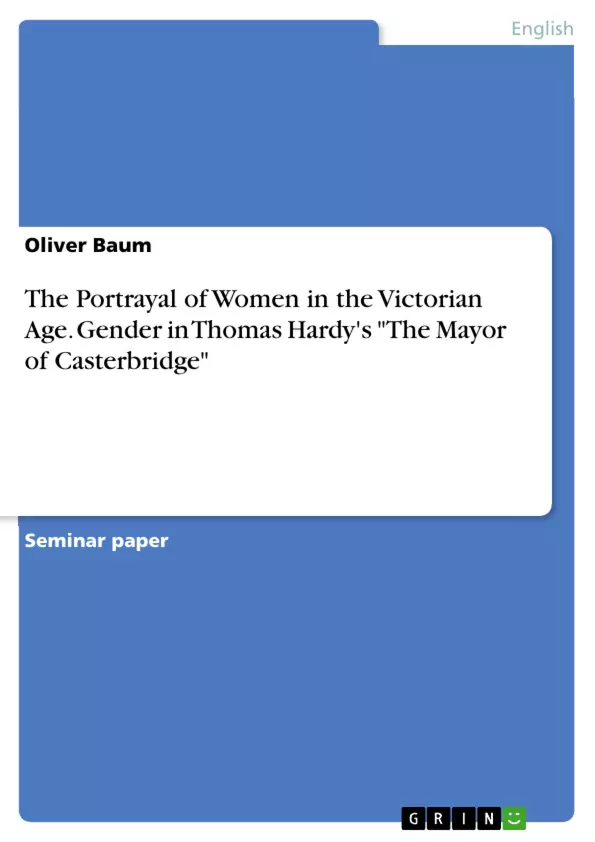This term paper focuses on the topic of gender and the investigation of Hardy’s portrayal of women as it emerges from the novel. In order to prove my thesis, I will reflect in how far Hardy follows major trends of Victorian fiction in The Mayor of Casterbridge. Next, I will depict the Victorian ideal of women with regard to fiction and society. Finally, I will prove my claim that Hardy’s ambivalent view of women, which embraces both conventional and modern ideals, is valid for The Mayor of Casterbridge, because it portrays women both as inferior and superior. Accordingly, I will show that Hardy’s heroines deviate from the prevalent Victorian ideal of women. Therefore, I will analyse crucial aspects like Hardy’s authorial point of view as well as Henchard’s relationship to Susan, Lucetta, and Elizabeth-Jane, in the novel.
My thesis matters because “[…] the appeal of Hardy as a novelist […] has long been vital, increasingly so in recent years […]”. Besides, “[t]he tension […] of Hardy’s representation of women […] makes his work one of the richest and most complex sources of feminist commentary in the realist novel”. Recent criticism of Hardy focused on Marxist and feminist theories by reassessing Hardy’s novels as revolutionary. This issue remains important because women have been oppressed for centuries, while Hardy’s fiction contributed to the women’s struggle for emancipation.
Inhaltsverzeichnis (Table of Contents)
- Abstract
- Gender in Thomas Hardy's The Mayor of Casterbridge
- The Mayor of Casterbridge within the Historical Context of the Victorian Age
- The Victorian Ideal of Women in Society and Fiction
- Hardy's Portrayal of Women in The Mayor of Casterbridge
- Conclusion
- Bibliography
Zielsetzung und Themenschwerpunkte (Objectives and Key Themes)
This paper examines the portrayal of women in Thomas Hardy's The Mayor of Casterbridge, exploring how Hardy's depiction of female characters reflects both traditional Victorian ideals and emerging modern perspectives. The paper aims to prove that Hardy's ambivalent view of women, embracing both conventional and modern ideals, is evident in the novel.
- Hardy's portrayal of women in relation to Victorian societal norms and literary conventions.
- The Victorian ideal of women and its impact on the portrayal of female characters in literature.
- Hardy's nuanced representation of women, showcasing both their limitations and strengths.
- Analysis of Hardy's authorial point of view and the relationships between the male protagonist, Henchard, and the female characters, Susan, Lucetta, and Elizabeth-Jane.
- The significance of Hardy's work in contributing to the women's struggle for emancipation.
Zusammenfassung der Kapitel (Chapter Summaries)
The paper begins by contextualizing The Mayor of Casterbridge within the historical and literary context of the Victorian era, highlighting key developments in society and literature during this time. It explores the Victorian ideal of women and its influence on the portrayal of female characters in fiction.
The paper then analyzes Hardy's portrayal of women in The Mayor of Casterbridge, focusing on how his characters deviate from the prevailing Victorian ideal. It examines the relationships between the main male protagonist, Henchard, and the female characters, and how these relationships illuminate Hardy's ambivalent view of women.
Schlüsselwörter (Keywords)
Key terms and concepts explored in this paper include: Victorian literature, gender roles, feminist criticism, Thomas Hardy, The Mayor of Casterbridge, women's emancipation, social Darwinism, realism, idealism, authorial point of view, character analysis.
- Quote paper
- M. A. Oliver Baum (Author), 2007, The Portrayal of Women in the Victorian Age. Gender in Thomas Hardy's "The Mayor of Casterbridge", Munich, GRIN Verlag, https://www.grin.com/document/280606



